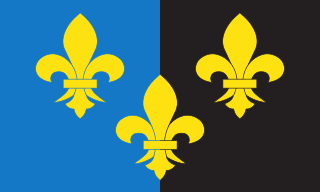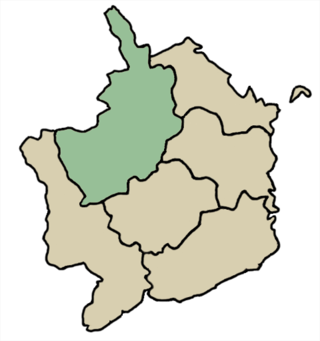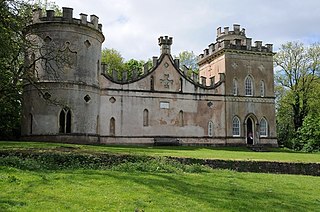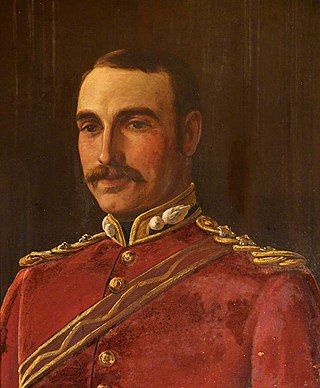Assessment
Bradney's work remains a valuable source for information on the county's history but its weaknesses have long been recognised. The architectural historian John Newman, writing in his Gwent/Monmouthshire Pevsner, noted that "Bradney's approach, with its emphasis on genealogies and monumental inscriptions, was out-of-date in its own day; but his pages are full of clues and cannot be ignored". His family histories came in for particular criticism. Sir Cyril Fox and Lord Raglan, in the first of their three-volume study Monmouthshire Houses , wrote of the pedigrees of the Monmouthshire families; "Sir Joseph Bradney gives a large number (which) trace their ancestry to Welsh kings or Norman lords but are, like those of their English contemporaries, mostly fictitious". Canon E.T. Davies, in his 1986 study, Bradney's "History of Monmouthshire": An Assessment, placed Bradney in a "particular tradition in which country gentlemen wrote for country gentlemen". Considering him more of a genealogist than a historian, Davies levelled two particular charges: his reliance on weak sources for his early history of the county, such as Geoffrey of Monmouth, and Iolo Morganwg, who had been exposed as a forger while Bradney was engaged on his work; and his lack of interest in, and coverage of, Monmouthshire's later industrial history; "his vision fixed on the old, historic, agricultural Monmouthshire…, the inadequate treatment of a new industrial society emphasised a fatal weakness in Bradney's history". In the Glamorgan-Gwent Archaeological Trust survey, Gwent Historic Churches carried out for Cadw in 1997, E. M. Evans noted that Bradney's lack of architectural training and understanding limited the value of his works, while appreciating his "transciptions of funerary monuments, some of which no longer survive." Despite its deficiencies, Bradney's industry and the sheer scale of his investigative work continue to be recognised; the historian of Gwent, Raymond Howell, writing in 1988, praised his "monumental efforts of half a century ago". Twenty years later, in his foreword to the second volume of the Gwent County History, The Age of the Marcher Lords, c.1070-1536, Martin Culliford acknowledged the debt to Bradney, and to William Coxe, when paying tribute to the contributors to the history; "[they] are no longer just following in the hallowed footsteps of Archdeacon Coxe and Sir Joseph Bradney but by now have overtaken them".

Monmouthshire is a county in the south east of Wales. It borders Powys to the north; the English counties of Herefordshire and Gloucestershire to the north and east; the Severn Estuary to the south, and Torfaen, Newport and Blaenau Gwent to the west. The largest town is Abergavenny, and the administrative centre is Usk.

Until 1974, Monmouthshire, also formerly known as the County of Monmouth, was an administrative county in the south-east of Wales, on the border with England, and later classed as one of the thirteen historic counties of Wales. Its area now corresponds approximately to the present principal areas of Monmouthshire, Blaenau Gwent, Newport and Torfaen, and those parts of Caerphilly and Cardiff east of the Rhymney River.

Abergavenny was an ancient hundred of Monmouthshire.

Wilcrick is a hamlet within the administrative boundary of the city of Newport, South Wales, just to the west of Magor and approximately 7 miles (11 km) southeast of Newport city centre. It is within the historic county of Monmouthshire.

Gwent was a medieval Welsh kingdom, lying between the Rivers Wye and Usk. It existed from the end of Roman rule in Britain in about the 5th century until the Norman invasion of Wales in the 11th century. Along with its neighbour Glywyssing, it seems to have had a great deal of cultural continuity with the earlier Silures, keeping their own courts and diocese separate from the rest of Wales until their conquest by Gruffydd ap Llywelyn. Although it recovered its independence after his death in 1063, Gwent was the first of the Welsh kingdoms to be overrun following the Norman conquest.

Clytha Castle is a folly near Clytha between Llanarth and Raglan in Monmouthshire, south east Wales. Dating from 1790, the castle was built by William Jones, owner of the Clytha Park estate as a memorial to his wife, Elizabeth, who died in 1787. The castle is an example of the Gothic Revival and comprises three towers, of which two are habitable, and linking, castellated curtain walls. Long attributed to John Nash, recent research has confirmed that the architect was John Davenport of Shrewsbury. The folly has views towards the Sugar Loaf and Skirrid mountains on the easternmost edge of the Brecon Beacons National Park. Described by the architectural historian John Newman as one of the two "outstanding examples of late eighteenth century fanciful Gothic in the county", Clytha Castle is a Grade I listed building.

Llantilio Crossenny is a small village and much larger former community, now in the community of Whitecastle, in Monmouthshire, south east Wales, in the United Kingdom. It is situated between the two towns of Abergavenny and Monmouth on the B4233 road. The community included Penrhos, and Llanvihangel-Ystern-Llewern.

Colonel Sir Joseph Alfred Bradney, was a British soldier, historian and archaeologist, best known for his multivolume A History of Monmouthshire from the Coming of the Normans into Wales down to the Present Time.

The Cross at Croes Llwyd Farm, Raglan, Monmouthshire is a medieval cross which indicated a boundary of the Lordship of Raglan. As a rare medieval survival, it is both a Grade I listed structure and a Scheduled monument.

Monmouthshire is a county and principal area of Wales. It borders Torfaen and Newport to the west; Herefordshire and Gloucestershire to the east; and Powys to the north. The largest town is Abergavenny, with the other major towns being Chepstow, Monmouth, and Usk. The county is 850 km2 in extent, with a population of 95,200 as of 2020. The present county was formed under the Local Government (Wales) Act 1994, which came into effect in 1996, and comprises some sixty percent of the historic county. Between 1974 and 1996, the county was known by the ancient title of Gwent, recalling the medieval Welsh kingdom. In his essay on local government in the fifth and final volume of the Gwent County History, Robert McCloy suggests that the governance of "no county in the United Kingdom in the twentieth century was so transformed as that of Monmouthshire".

Monmouthshire is a county of Wales. It borders Torfaen and Newport to the west; Herefordshire and Gloucestershire to the east; and Powys to the north. The largest town is Abergavenny, with the other major towns being Chepstow, Monmouth, and Usk. The county is 850 km2 in extent, with a population of 95,200 as of 2020. The present county was formed under the Local Government (Wales) Act 1994, which came into effect in 1996, and comprises some sixty percent of the historic county. Between 1974 and 1996, the county was known by the ancient title of Gwent, recalling the medieval Welsh kingdom. In his essay on local government in the fifth and final volume of the Gwent County History, Robert McCloy suggests that the governance of "no county in the United Kingdom in the twentieth century was so transformed as that of Monmouthshire".

St Cenedlon's is a parish church in the village of Rockfield, Monmouthshire, Wales. The dedication to St Cenedlon is unusual and the history of the saint is obscure. Some sources suggest that she was a daughter of Brychan king of Brycheiniog while others identify her as the wife of King Arthfael ab Ithel, king of Glywysing. The existing church dates from the Middle Ages but only the tower remains from that period. After the English Reformation, the surrounding area of north Monmouthshire became a refuge for Catholics and Matthew Pritchard (1669-1750), Roman Catholic bishop and Vicar Apostolic of the Western District is buried at the church. By the mid-19th century the church was in ruins and a complete reconstruction was undertaken by the ecclesiastical architects John Pollard Seddon and John Prichard in around 1860. St Cenedlon's is an active parish church in the Diocese of Monmouth. It is designated by Cadw as a Grade II listed building.

Pentwyn, Rockfield, Monmouthshire is a Victorian villa dating from the mid 19th century. Its origins are older but the present building was constructed by the Monmouth architect George Vaughan Maddox for himself in 1834–1837, and subsequently altered by him after a later sale. It was partly converted into apartments for letting in the 20th century before reverting to use as a family house. The house is Grade II* listed.

Llansantffraed is the smallest parish in Monmouthshire, Wales, located four miles to the west of Raglan, north of the A40 between Raglan and Abergavenny. There is no community, only the Llansantffraed Court estate and the church.

Old Trecastle Farmhouse, Pen-y-clawdd, Monmouthshire is a farmhouse, originally, a gentry house, dating from the 16th and 17th centuries. It stands on the site of the outworks of a Norman motte-and-bailey castle. The house is Grade II* listed.

Ton Farmhouse, Llangybi, Monmouthshire is a farmhouse dating from the early 17th century. John Newman, in his Monmouthshire Pevsner, describes it as a "perfect Monmouthshire farmhouse". Ton is a Grade II* listed building, its listing noting that it is a "remarkably good survival" of a prosperous 17th century Welsh farmhouse.

Maerdy Farmhouse (The Maerdy), Llanvihangel-Ystern-Llewern, Monmouthshire is a farmhouse dating from about 1700. Extended later in the 18th century, it is an early example of the use of brick, rather than stone, in Monmouthshire. The farmhouse is Grade II* listed with its stableblock and shelter shed, and its barn and cider house having their own Grade II listings.

Brynderi House, in the hamlet of Brynderi, Llantilio Crossenny, Monmouthshire is a country house with origins in the mid-18th century. The house was extensively rebuilt in the early 19th century in a Regency style. In the later 19th century the house become the dower house for Llantilio Court. A Grade II* listed building, it remains a private residence.

Berllan-deg, Llanhennock, Monmouthshire is a country house dating from the mid-17th century. A rare survival of a remarkably unaltered hall house, Berllan-deg is a Grade II* listed building.

Perth-hir House, Rockfield, Monmouthshire, Wales, was a major residence of the Herbert family. It stood at a bend of the River Monnow, to the north-west of the village. At its height in the 16th century, the mansion, entered by two drawbridges over a moat, comprised a great hall and a number of secondary structures. Subsequently in the ownership of the Powells, and then the Lorimers, the house became a centre of Catholic recusancy following the English Reformation. By the 19th century, the house had declined to the status of a farmhouse and it was largely demolished in around 1830. Its ruins, and the site which contains considerable remnants of a Tudor garden, are a scheduled monument.



















